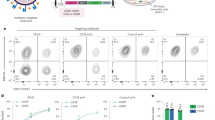Abstract
Homologous restriction factor 20 (HRF20, CD59) is one of the complement regulatory factors. In this study, the complement-resistant retroviral vector, which possesses the HRF20 gene as a selection gene, was constructed and examined. The virus-producing cell, transduced with complement-resistant retroviral vector, was established after complement-dependent selection. NIH3T3 and PK15 cells transduced with this virus-producing cell were suc- cessfully selected by complement-dependent selection, which showed significant expression of the HRF20 antigen. In addition, these cells, transduced with tissue plasminogen activator (tPA) cDNA using complement-resistant retroviral vector, expressed tPA antigen after complement-dependent selection. These findings suggest that complement-resistant retroviral vector can be used for the double transduction of HRF20, as well as other genes.
This is a preview of subscription content, access via your institution
Access options
Subscribe to this journal
Receive 12 print issues and online access
$259.00 per year
only $21.58 per issue
Buy this article
- Purchase on Springer Link
- Instant access to full article PDF
Prices may be subject to local taxes which are calculated during checkout
Similar content being viewed by others
Author information
Authors and Affiliations
Rights and permissions
About this article
Cite this article
Hayashi, S., Emi, N., Okada, H. et al. Establishment of complement-resistant retroviral vector by homologous restriction factor 20 gene. Gene Ther 5, 282–285 (1998). https://doi.org/10.1038/sj.gt.3300574
Received:
Accepted:
Published:
Issue Date:
DOI: https://doi.org/10.1038/sj.gt.3300574
Keywords
This article is cited by
-
Incorporation of decay-accelerating factor into the baculovirus envelope generates complement-resistant gene transfer vectors
Nature Biotechnology (2001)
-
Complement and anti-α-galactosyl natural antibody-mediated inactivation of murine retrovirus occurs in adult serum but not in umbilical cord serum
Gene Therapy (1999)



